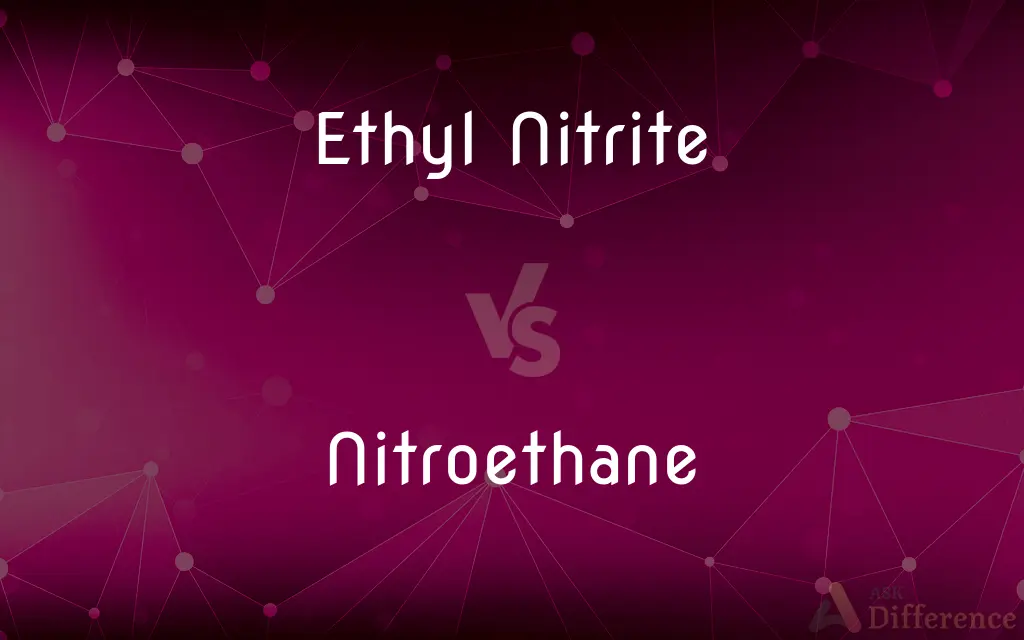Ethyl Nitrite vs. Nitroethane — What's the Difference?
Edited by Tayyaba Rehman — By Urooj Arif — Published on March 4, 2024
Ethyl nitrite is an organic compound used as a vasodilator and in perfumery, characterized by its formula C2H5ONO. Nitroethane, C2H5NO2, is an organic solvent used in industrial applications, distinct for its nitro group attached to an ethane backbone.

Difference Between Ethyl Nitrite and Nitroethane
Table of Contents
ADVERTISEMENT
Key Differences
Ethyl nitrite, with the chemical formula C2H5ONO, is known for its applications in medicine as a vasodilator and in the fragrance industry. It acts by relaxing blood vessels, which can help to alleviate chest pain and support other therapeutic effects. Its distinctive sweet smell also makes it useful in perfumery and flavorings.
Nitroethane, C2H5NO2, serves a different purpose, primarily used as a solvent in industrial settings, including the synthesis of other chemicals. Its structure features a nitro group (-NO2) attached to an ethane molecule, giving it properties suited for applications in organic synthesis, adhesives, and coatings.
The key difference between these two compounds lies in their functional groups and resultant uses. Ethyl nitrite's -ONO group facilitates its role in medical and fragrance applications, whereas nitroethane's -NO2 group aligns it with industrial and synthetic uses.
Despite both compounds containing similar carbon and hydrogen backbones, their chemical behavior and applications diverge significantly due to the differences in their molecular structures. This divergence illustrates the impact of functional groups on the properties and uses of organic compounds.
Ethyl nitrite is volatile and highly flammable, requiring careful handling and storage. Its rapid evaporation at room temperature makes it effective for inhalation therapies. On the other hand, nitroethane's lower volatility and solvent properties make it suitable for more stable industrial applications.
ADVERTISEMENT
Ethyl nitrite and nitroethane share a common ethyl backbone, while their differing functional groups (-ONO in ethyl nitrite and -NO2 in nitroethane) dictate their distinct physical properties, uses, and handling requirements.
Comparison Chart
Chemical Formula
C2H5ONO
C2H5NO2
Functional Group
Nitrite (-ONO)
Nitro (-NO2)
Primary Use
Vasodilator, perfumery
Solvent, chemical synthesis
Odor
Sweet, fruity
Slightly sweet, pungent
Volatility
High
Moderate
Flammability
Highly flammable
Flammable
Stability
Less stable, rapid evaporation
More stable, less volatile
Applications
Medical, fragrance
Industrial, adhesives, coatings
Compare with Definitions
Ethyl Nitrite
Utilized in flavorings.
Ethyl nitrite imparts a unique taste to certain food products.
Nitroethane
Features a nitro group in its structure.
The -NO2 group makes nitroethane a powerful solvent.
Ethyl Nitrite
Highly flammable and volatile.
Ethyl nitrite evaporates quickly when exposed to air.
Nitroethane
Applied in chemical synthesis.
Nitroethane serves as a precursor in pharmaceutical manufacturing.
Ethyl Nitrite
A vasodilator used in medicine.
Ethyl nitrite is administered to relieve angina symptoms.
Nitroethane
An organic solvent used industrially.
Nitroethane is a key ingredient in paint removers.
Ethyl Nitrite
Characterized by its nitrite functional group.
The -ONO group in ethyl nitrite dictates its reactivity.
Nitroethane
Moderately volatile and flammable.
Nitroethane requires careful handling in industrial settings.
Ethyl Nitrite
Employed in perfumery for its sweet smell.
Ethyl nitrite adds a fruity note to fragrances.
Nitroethane
Used in adhesives and coatings.
Nitroethane enhances the performance of certain epoxy resins.
Nitroethane
(organic compound) The aliphatic nitro compound CH3-CH2-NO2 that is used as a specialist solvent, and as a fuel additive
Common Curiosities
How are ethyl nitrite and nitroethane different?
The primary difference lies in their functional groups and applications: ethyl nitrite serves medical and fragrance purposes, whereas nitroethane is used in industrial settings.
What is ethyl nitrite?
Ethyl nitrite is an organic compound used as a vasodilator and in perfumery, known for its sweet, fruity odor.
What is nitroethane?
Nitroethane is an organic compound used as a solvent in various industrial applications, featuring a nitro group attached to an ethane molecule.
Can ethyl nitrite and nitroethane be used interchangeably?
No, due to their distinct chemical properties and applications, they are not interchangeable.
What is the significance of the sweet odor of ethyl nitrite?
Its odor makes it valuable in perfumery and flavorings, adding desirable notes to products.
Are ethyl nitrite and nitroethane flammable?
Yes, both compounds are flammable, with ethyl nitrite being highly flammable and volatile.
Can nitroethane be used in the food industry?
No, nitroethane's primary use is in industrial applications and is not suitable for food products.
Can nitroethane affect the environment?
Yes, like many solvents, improper disposal or release can harm the environment.
Why is nitroethane used as a solvent?
Its chemical structure, particularly the nitro group, gives it properties that make it effective for dissolving other substances in industrial processes.
How does the presence of a nitrite or nitro group affect a compound's properties?
These groups significantly influence a compound's reactivity, stability, and applications, with nitrites often being more volatile and nitro compounds being more stable.
How are these compounds typically stored?
They should be stored in cool, well-ventilated areas away from sources of ignition.
Is ethyl nitrite safe for inhalation?
While it has been used for medical inhalation under controlled conditions, safety depends on the dosage and context of use.
How does the volatility of ethyl nitrite impact its use?
Its high volatility facilitates quick evaporation, which is useful in inhalation therapies but requires careful handling and storage.
What precautions should be taken when handling these chemicals?
Proper protective equipment and adherence to safety guidelines are essential due to their flammability and potential health hazards.
Share Your Discovery

Previous Comparison
Venting vs. Complaining
Next Comparison
Indoor Basketball vs. Outdoor BasketballAuthor Spotlight
Written by
Urooj ArifUrooj is a skilled content writer at Ask Difference, known for her exceptional ability to simplify complex topics into engaging and informative content. With a passion for research and a flair for clear, concise writing, she consistently delivers articles that resonate with our diverse audience.
Edited by
Tayyaba RehmanTayyaba Rehman is a distinguished writer, currently serving as a primary contributor to askdifference.com. As a researcher in semantics and etymology, Tayyaba's passion for the complexity of languages and their distinctions has found a perfect home on the platform. Tayyaba delves into the intricacies of language, distinguishing between commonly confused words and phrases, thereby providing clarity for readers worldwide.
















































